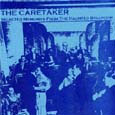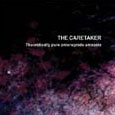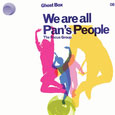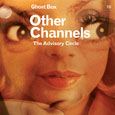
Hauntology: A Primer [2010-10-30]"The spectral rumour now resonates, it invades everything: the spirit of the "sublime" and the spirit of "nostalgia" cross all borders" Derrida, J. Specters of Marx pg169The invention of genre names by journalists in order to describe new or emerging forms of music is a bugbear of most music fans. That these names are often taken up by the industry almost as soon as they are spoken and used to sort, categorise and even marginalise the creativity of those working at the cutting edge is perhaps one source of this animosity. The relationship between sellers of art and those whose business it is to talk about it form an articulated whole that for the most part does more to stifle artistic product than encourage it. Once the name takes hold and is heard echoing down the corridors of major labels it doesn’t take long for its function to move from the merely descriptive to the narrowly prescriptive, marking out the limitations of a newly established orthodoxy, losing its radical edge and becoming as rationalised and commodified as any other popular music. The music industry needs a constant stream of new names, new genres through which to maintain consumption, to re-ignite desire for the new, or perhaps simply to reform the old in a brighter sexier package. So, it is not surprising that the attention given in recent years by music journalists to the concept of hauntology has evoked as much ironic raising of eyebrows as it has serious discussion. In order the steer a path away from the predictable journalistic function much of this article will address the wider cultural and philosophical import of hauntology. My central theses and, what I hope to demonstrate with this primer is that there is a formal set of relations operating within the music of the artists below and, its influence and affect is something quite different from what has gone before. More than that, this formal set is one which (paradoxically, considering hauntology is mostly described as a genre) is not confined to one type or genre of music. In the final part of this article I will argue where I think this spectre, this ghost that is hauntology is heading next. Popularised by critics such as Simon Reynolds and Mark "K-Punk" Fisher it has become synonymous with a group of artists working primarily in electronic music who demonstrate a curiously nostalgic and yet thoroughly modern approach to past musical and cultural forms. The Caretaker with his woozy re-appropriation of pre-war ballroom music, the Ghost Box label whose artists combine BBC radiophonic workshop style analogue electronics with 60s kitsch and public service broadcasts, and then there is Burial the secretive South Londoner whose records have become a touchstone for a uniquely mournful, yearning kind of urban music. What all these artists exhibit is an approach to the past which is other than a simple re-appropriation or pastiche. What hauntology is is a radically different relationship to that past, the lost opportunities of which still haunt us today as their unrealised potential. It is this paradoxical idea of a future that never came, of other possible worlds that may still be present, or maybe yet to come, which constitutes the central feature of those artists grouped under the name hauntology. The origin of the term comes from a text by the French philosopher Jacques Derrida titled Specters of Marx. The themes and concerns of the book are numerous and I wont attempt a discussion of them here, but a short quote should demonstrate the core idea of a past the existence of which still haunts us within what may be called our political or cultural unconscious. "To haunt does not mean to be present, and it is necessary to introduce haunting into the very construction of a concept. Of every concept, beginning with the concepts of being and time. That is what we would be calling here a hauntology. Ontology opposes it only in a movement of exorcism. Ontology is a conjuration." Derrida, J. Specters of Marx pg202 To focus on conjuration; a word that implies a bringing forth, like a sorcerer conjuring up some hitherto unknown power. First and foremost to conjure is to evoke through a saying or incantation something that while not present is not entirely absent either. Such a concept requires a departure from the usual understanding of presence and absence, being and non-being, which is why Derrida chose the play on words which is Hauntology; a combination of haunt (like a spirit or undead thing) and ontology, the philosophical study of what exists. Perhaps then in returning to music we can imagine that what these musicians are doing is a form of conjuration, a bringing forth of those lost moments, those unrealised potentials from our cultural past that have remained with us, haunting our present and emerging in these uncanny incantation of sound. If all this appears a little too academic or literary then hopefully the following review of some of the seminal works associated with hauntology may reveal both a more practical application along with its richness of thought. One final point remains. It could be argued that this whole hauntology business is something of an instance of the emperors new clothes, that the nostalgic re-articulation of material from our musical past has been going on since the first attempts at tape splicing back in the 1950s. It is true indeed that those techniques first pioneered under the name musique concrete are still being deployed in their digital form by today’s electronic musicians, and that there has been a fairly constant interest in classic analogue sounds ever since the first analogue versus digital debates erupted. Furthermore we could also point to works like Gavin Bryars The Sinking of the Titanic (1969), or William Basinski’s music utilising decaying tape loops to find that aspect of spectral re-imagining of the past which is associated with hauntology. I will concede this and certainly not deny that progenitors of hauntology are numerous. However, insofar as the artists below, grouped under the sign of hauntology represent a seemingly consistent set, each working from their own concerns, and yet demonstrating this core formal aspect towards both sound and, (for want of a better word) yearning towards the past, I think it appropriate to draw a line of demarcation and to begin the story of hauntology with the Caretaker’s debut album.  
The Caretaker - Selected Memories from the Haunted Ballroom (VVM, 2001)
- Theoretically Pure Anterograde Amnesia (VVM, 2006)The Caretaker, aka Leyland Kirby of the now defunct VVM records deals in the type of hazy, dark ambient influenced music that wouldn’t sound out of place in a David Lynch film. His moniker and the name of his debut take their influence from Stanley Kubrick’s The Shining. His music recalls those somnambulistic drifts through the haunted hotel, the bizarre conversations with Mr Grady ("you are the caretaker, you’ve always been the caretaker"), and all that past horror hidden under the surface just beyond the sound of the band playing in the vast ballroom. This dread and portent pile up over almost seventy-five minutes of distorted 78s circa 1939, all filtered through a think electronic fog of drone, glitch and noise. The signifying effect is perhaps more of a slow burn than the other hauntologist but there is no denying the utterly uncanny sound on this debut. There is a raw unfettered quality to The Caretaker’s debut the heights of which he never quite matched again. Much of the strangeness of this music is achieved by the juxtaposition of barely treated vocal tracks such as Arthur Schwartz’ You and the Night and the Music next to slabs of atonal noise and claustrophobic drone pieces. Strung together in a manner that suggest as much of an attempt to shock as to haunt, the noise element of The Caretakers output would more or less vanish after this debut. The record contains many of the signature elements that have become associated with hauntological music including a penchant for vinyl like distortion and surface noise, the smudging and de-contextualisation of vocals, and a focus on layered almost desolate sounding acoustic space. Five years later with Theoretically Pure Anterograde Amnesia; a mammoth 6CD set with no track titles we have moved to a preoccupation with memory, or more particularly the inability to create new memories. Mark Fisher in his sleeve notes for the set put it succinctly: "Let’s not imagine that this condition afflicts only a few unfortunates. Isn’t, in fact, theoretically pure anterograde amnesia the post-modern condition par excellence? The present - broken, desolate - is constantly erasing itself, leaving few traces." The record itself is a labyrinth of drawn out distortion and auditory artefacts, gone even are the rudimentary juxtapositions of noise, glitch and kitsch. Whatever spectre haunts this record its origins are unknown to us. Without bearings or even the ability to think an escape we find ourselves trapped in an endless present, the bad infinity. How did we get into this place? we can no longer remember. All that came before is endlessly recycled, circulated and the surplus extracted. Theoretically Pure Anterograde Amnesia is the sound of the ruinous shell that is left behind. The Caretaker marks the desolate borders around our current condition.  
The Focus Group - We are all Pan’s People (Ghost Box 2007)
The Advisory Circle - Other Channels (Ghost Box 2008)"not just a record label, but an imaginary world" Ghost Box Music has pretty much become the signature label of the mainstream understanding of hauntology. Their particularly English brand of queasy nostalgia and love of vintage electronics appeals as much to the Dr Who fan as to the more academic minded musicologist (although sometimes these are same people!). Founded by Julian House and Jim Jupp in 2004 they have quickly made a reputation for themselves with releases from The Focus Group, Belbury Poly, Eric Zann and The Advisory Circle. A Ghost Box release will typically contain samples from obscure 1960/70s TV shows, public service broadcasts or educational videos, library music, nods to the golden age of tape collage, and a rather large dose of surreal English wit. All this wrapped up in a consistently gorgeous design aesthetic that looks as if could have come through a portal direct from 1970 via Penguin books. We are all Pan’s People by the Focus Group is a psychedelic trawl through dusty recordings of a skewed public event gone wrong, sounding somewhere between Jodorowsky’s Holy Mountain soundtrack and Delia Derbyshire on a bad LSD trip. As well as all this surreal humour and high kitsch there is also a feeling present on all Ghost Box records of loss, perhaps even melancholia. This feeling is especially acute on The Advisory Circle’s superlative Other Channels. Tracks like Mogodon Coffee Morning spice together banal pieces of incidental conversation, a fabulously trippy backing of phased lounge jazz and mournful strings over which flutters a pure sine wave melody. It’s melancholy to the extreme, conjuring images of long lonely days spent whiling away the time in the local greasy spoon, nameless faces coming and going, prospects limited, the coffee enough only to wake you up to another day in Thatcher’s Britain. These songs could hardly be described as arriving through rose tinted spectacles, and indeed it would be a mistake to view records such as Other Channels or the recent Belbury Poly album From a Distant Star (breaking through to mainstream recognition with a positive review in the Guardian) as simply an orgy of kitsch, an exercise in purely retrograde nostalgia for the good old days before Dr Who got sexed up and the X-factor sausage factory began grinding away. In Jim Jupp’s words: "Like all the Ghost Box stuff, it’s an imaginary past. But given that, it’s from the late-70s of this imaginary past, if that makes sense?" (1)What we have here is that same distinction described in the introduction between reportage of the past and narritivising of a time that never took place. Or again with Jupp: "a nostalgia for nostalgia", a time when we could think beyond the confines of mass produced music towards the possibility of new sounds and new worlds. To put it another way: what Ghost Box and others like them articulate is not what is lacking in today’s cultural experience (authenticity, originality, genuine possibility away from the pressures of consumerism) but the lack of this lack; an inability even to imagine what it was the possibility of which went away during the epochal shifts in political and economic reality in the period 1970-1990. The other world that the mock TV broadcasts of Ghost Box Music seem to soundtrack is one which has no linear path from its time to ours. As Jupp said, his 1970s never happened and therefore the present, the point from which he is articulating this nostalgia is also one which has yet to come. If hauntology refers to any world other than our own it is precisely this absent present that is yearned for in the reconfiguring of a past where other futures were yet to be foreclosed. 
Mordant Music - Dead Air (Mordant 2006)Mordant Music, while utilising much of the sound pallet familiar to Ghost Box manifest their own particular brand of dystopic temporality. If it could be said that the output of Ghost Box rearticulates those points of possibility that have long past, what Mordant Music have produced with Dead Air is a type of Cronenbergian disfigurement of past forms, mashing them together, exposing the fragile material within. Here we find Philip Elsmore (continuity announcer for Thames television during the station’s entire 24 year history) narrating throughout an album incorporating a warped mix of degraded electro, dubstep / grime rhythms, and deformed musique concrete. The work here is done by the counterpoising of otherwise thoroughly inconsistent sources of audio to produce a signifying effect not unlike that of wandering through a museum exhibition where fragments of speech, music and acousmatic sound drift in and out of audibility. One sequence of tracks has the narrator recalling stories from his time at the station while a guitar loop cycles above it, seemingly arbitrary in its presence. Those ghosts from electronic music’s past are legion as Pierre Henry style tape manipulations swarm about Elsmore’s testimony before being broken up by a section formed of gutted remnants of the heyday of rave. Mordant’s time is not a mythical childlike Eden of 1970s Britain, theirs is truly a dead museum of all time beginning with the classic age of tape splicing and ending with the death of rave in the early 1990s. It is as if every opening, every potential avenue of otherness that was opened up in culture during that time has been preserved in formaldehyde, misshapen along the grotesque gallery that is Dead Air. What is offered here is not an experience of nostalgia or even an encounter with the real of loss and disenchantment; Dead Air is at its core the mutant inarticulate offspring of all those past times represented from the perspective of a truly dystopic present. Philip Elsmore's reassuring voice no longer announcing the latest episode of Magpie appears as a reaper nihilating each track from within, leaving a fractured, utterly out of joint sense of time, place and meaning. What The Caretaker points to with his Theoretically Pure Anterograde Amnesia is demonstrated by Mordant Music from a point of time where the inability to form new memories, to think an escape from the endless present has resulted in the disintegration of the past, endlessly repeated, regurgitated, any feeling of rootedness has been lost to a plethora of temporal fragments, partial objects, of a history that is now totally alien to us. 
Burial - Untrue (Hyperdub 2007) "When I'm awake all night, sometimes I see the people and the city waking up around me. I feel a little bit moody at them for stepping into my night-time. What I want is that feeling when you're in the rain, or a storm. It's a shiver at the edge of your mind, an atmosphere of hearing a sad, distant sound, but it seems closer - like it's just for you. Like hearing rain or a whale-song, a cry in the dark, the far cry." Burial (William Bevan) 2007 (2) Burial’s debut album released in 2006 was a surprise hit, appearing on numerous best-of lists including taking the number one spot in the Wire magazine. It was a subterranean mix of short-wave crackle, dubstep rhythms and shadowy ambience punctuated with those half-heard cries in the dark that William Bevan (Burial’s secretive creator) sought to evoke from rave’s past. Taking his cue from early jungle and 2step garage Burial’s music shapes the beats against a hollowed out atmosphere of darkside ambience and unplaceable samples. Ramping up the atmosphere at the expense of dancability this is rave music for when rave died. Untrue appeared in 2007 with the same intense focus on atmosphere but with a curious element of euphoria (or should that be dysphoria) deep within its melancholic heart. The range and density of the vocal samples were increased the effect of which is to render the music almost choral in parts. Etched Headplate begins with fragments of dialogue that could have been culled from the local news programmes, before a female voice pitch shifted and time-stretched sings a half-heard melody, lost in the night amongst the radio crackle and distant strings. Titles such as In McDonalds, Dog Shelter and Homeless make clear that this is music which has its roots in a very ordinary urban South London. This isn’t the sound of trendy bars on the Southbank or middle class dinner parties held in gated communities in Putney. Get on a bus at night and travel down the Old Kent Road and you will hear all the sounds that Bevan splices together in his music. It’s the sound of disenfranchised alienated youth, longing for something more. All the songs on Untrue are packed with barely audible found sounds and sonic artefacts. A vinyl slip, the flick of a lighter or the sound of metal on concrete. Voice is ever present, either as incidental sound; as if picking up a fragment of conversation on passing strangers in the street, or as the distorted emotionally longing voice of a singer on some forgotten house record. Burial strips down his vocal samples utterly removing them from their original context and flings them into the dark. Pierre Schaeffer described this approach to sound as Acousmatic: the veiling or detaching of sounds from their source generating an often uncanny effect of dislocation. However in Burial the acousmatic effect is combined with a linguistic one. Voices repeat some phrase or part phrase, but the full meaning is lost by truncating and abstracting it from the totality of the original vocal. Many of the samples are taken from what could reasonably be described as cheesy dance music, but as partial objects their history is erased. What remains is the trace of some meaning that once was, and a place where some future signification might come to be but which in the music is being endlessly deferred. In effect what Burial has done through abstracting and treating these voices is to render them temporally out of joint. In doing so their signification falls away and the very absence of meaning is rendered palpable as a void. This void of meaning which is affected by the voice is the source of that unique sense of loss and melancholy that marks out Burial’s music. Burial is different in respect to the other hauntologists we have been discussing in that he doesn’t attempt to evoke the past through homage ala Ghost Box or through The Caretaker’s spectral representations. Indeed as Bevan himself admits; "I’ve never been to a festival. Never been to a rave in a field. Never been to a big warehouse, never been to an illegal party, just clubs and playing tunes indoors or whatever. I heard about it, dreamed about it."(3) Burial’s music is not a function of nostalgia, rather than indulge in imitations of past glories none of which involved him Bevan articulates the longing for an alternative to the commercialised pre-packaged hedonism of the modern club experience. His is a experience of culture and a desire for rootedness that has no place in our present, so as with the other hauntologists he chops up and decontextualises what is given to him from a past that seemed more open, more charged with euphoria and potential. The difference in approach between Burial and the others is that while they obscure the void of meaning at the heart of their music with direct material re-appropriations of past forms, he appropriates only so much as to highlight that absent centre, the pure void around which the ghosts of the past circulate. Burial is the quintessential hauntologist.  
oOoOO - oOoOO (Tri-angle 2010)
Balam Acab - See Birds (Tri-angle 2010)
This article has attempted to show the commonalities or shared relations between the artists grouped under the sign of hauntology. One commonality which is however absent is that of a shared progenitor or, set of influences. As I stated above each of these artists (with perhaps the exception of the relation between Ghost Box and Mordant Music) articulate themselves along the lines of their own particular concerns with their grouping under hauntology more or less imposed from without, sometimes reluctantly. However, since Burial’s Untrue I would argue that hauntology as a way of doing music has found its common point of identification. Going further I would say that what Burial lays bare in his music can be retroactively assigned to each of these other artists to demonstrate what I believe to be the source of what I have been calling the signifying effect of hauntology in music. But this sadly is another story. What I want to do briefly here is to introduce two artists (on one label) who each cite Burial as an influence and whose grouping in the contested micro-genre known by the name of Witch House or Drag is where I believe the spectre of hauntology is now appearing. The musicians behind oOoOO and Balam Acab (Christopher Dexter Greenspan and Alec Koone respectively) both cite Burial as an influence.(4) This can be heard in the use of dislocated vocals and the overall blurred mildly drug addled soundscapes. Balam Acab’s sound is the most obviously indebted to dubstep, all-be-it a creepingly slow psychedelic version where the spectres of 90s rave are replaced with their counterparts in skewed 80s pop and psychedelia. Ethereal female voice is preferred by both artists. On Balam Acab’s Sea Birds the sampled voice is distorted into a nymph like presence behind languid dub beats and hazy synthesiser melodies. Whatever the words originally were have been smudged out of all recognition leaving just the intonation of some emotion, the specifics of which are unknown. As in Burial voice signifies the trace of meaning but not its content. oOoOO (Pronounced Oh) take less of the abstract dynamics of Balam Acab but ramp up the ethereal psychedelic atmosphere. You can hear just as much commercial pop as dub on their self titled debut EP, but again the sound has been seemingly decontextualised from its sources and rendered as a queasy downbeat expression of 80s pop aesthetics. Synth is layered thick across both records but it’s not the pitch perfect overproduced sound of modern pop music. Here the atonal is placed alongside the melodic with glassy eyed vocals sliding somewhere in between. Hearts and Burnout Eyess are two gorgeously constructed pop anthems on the oOoOO debut, epic in their scope, but lacking that sense of plastic euphoria and superficiality indicative of most chart music. The make-up is smeared, the eyes glazed, the beats go on with the pleading voice dragged behind, captive under the lights. The hauntological effect defers the final meaning of the music, its signification slides away like the saccharine intonation of the voice on these records, leaving the void within exposed. What Burial has done for post rave dance music artists like oOoOO, Balam Acab and White Ring are doing for 80s pop. That same feeling of loss, mourning and alternate worlds is being evoked. This mood, this haunted feeling is the zero level for hauntology. The spectre, as Derrida says, is evoked through conjuration, a saying or incantation. These cries in the dark that can be heard on all the records presented above are just such incantations. They are not the spectres themselves but in their speculative saying bring forth the void of meaning through which the listener becomes the medium for that lost past the ghosts of which are brought forth. What is essential to understand though is that these supposed ghosts were never living beings, for if they were what would be longed for would be a true lost past and, hauntology would simply be a nostalgic function. The spectres conjured up are those of a past that never came about, or a present that could have been different; a future that was once undecided. I am in agreement with those theorists such as Mark Fisher that see hauntology as a response to our current political and cultural situation, a direct consequence of the deadlocks of late capitalism. Pop music endlessly repeating itself, commercialism extinguishing all glimmers of originality and freedom of expression. It is not surprising that under these condition when the possibility of thinking outside the capitalist framework has become so difficult, that the music made at the margins expresses itself in an articulation of despondency. Hauntology makes no demands. It does however expose the very material reality upon which demands can be made; an understanding that things were once different, and a realisation (dare I say a revelation) that things do not have to be the same in the future. The spectre is the void, the very contingency of meaning, to encounter the void is already to think differently. Notes:
1 - http://www.cyclicdefrost.com/blog/2009/04/12/belbury-poly-interview-by-emmy-hennings/
2 - http://www.guardian.co.uk/music/2007/oct/26/urban
3 - IBID
4 - http://pitchfork.com/features/articles/7806-ghosts-in-the-machine/
Duncan Simpson
|

